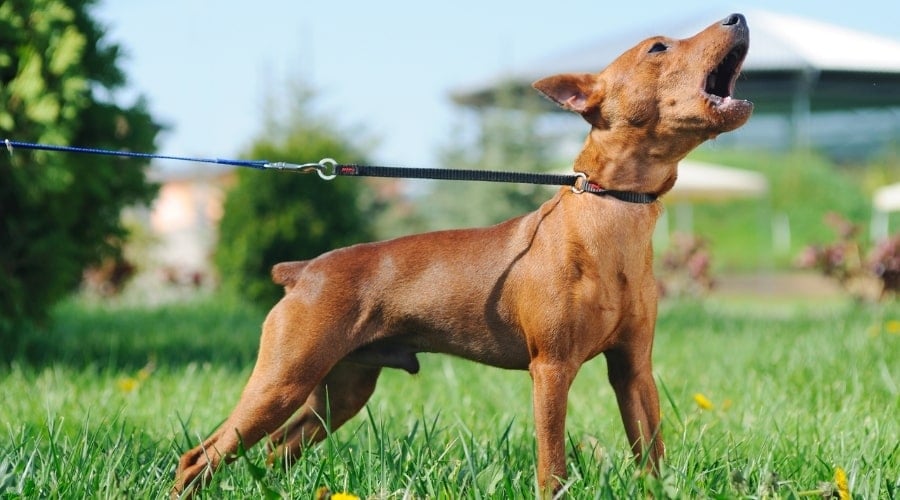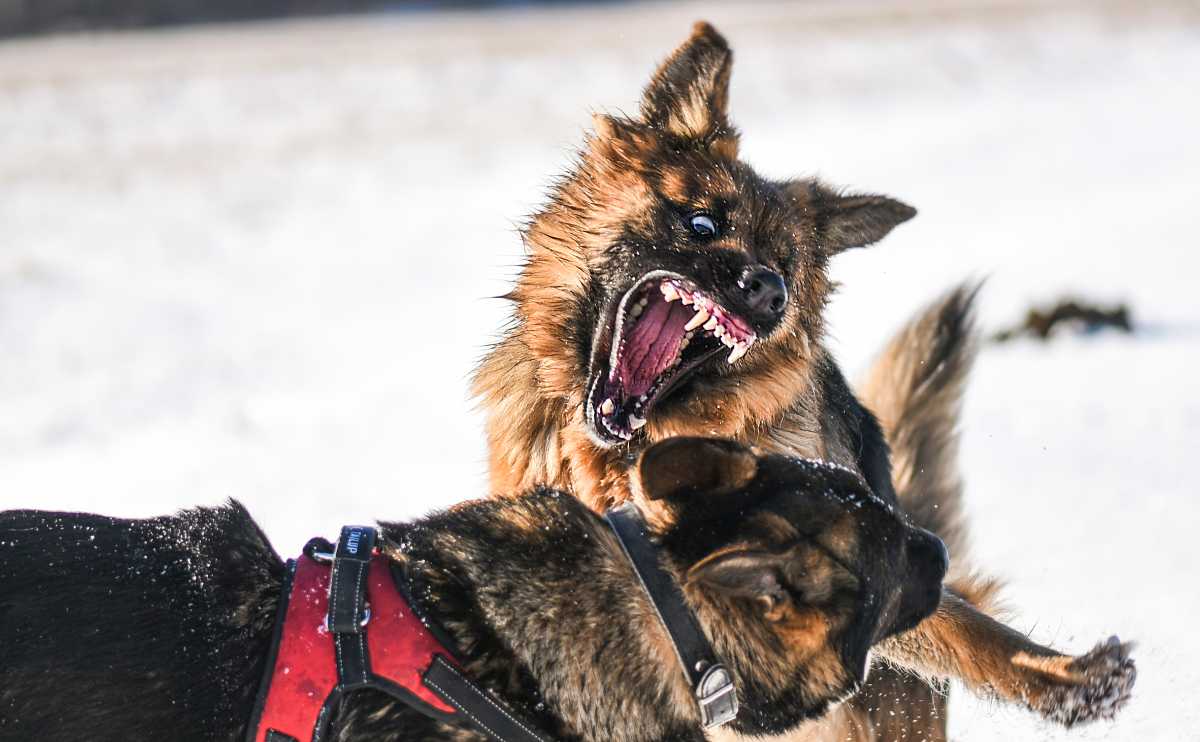Dog Body Language: The Hidden Messages Revealed
When you purchase through links on our site, we may earn a commission. Here’s how it works.
Dogs may not speak our language, but they constantly talk to us. Every wag of the tail, head tilt, or ear twitch says something about how they feel. When we learn to read these signals, we unlock a whole new way of connecting with our four-legged friends. Understanding dog body language may be the key to a better-behaved pup and a stronger connection with you.
Table of Contents

You don’t need to be a dog whisperer to know when a pup feels playful, scared, or upset. Just pay attention to their body language. A happy dog might flash a goofy grin and bounce excitedly, while a nervous one could lower its ears or tuck its tail. Even their eyes can speak volumes.
Understanding your dog’s facial expressions, tail movements, and ear positions helps you respond with care and confidence. The more you listen with your eyes, the stronger your bond will grow.
Decoding Your Dog’s Signals: What Are They Telling You?
Your dog is constantly “talking,” just without the words. Once you learn the basics of doggy body language, you’ll start to hear them loud and clear. And honestly, they have a lot to say.
Dogs, like people, have moods that shape how they act. Most dog behavior fits into four primary mindsets:
- Aggressive
- Submissive
- Timid
- Excited
But don’t expect dogs to stick to just one at a time. They’re emotional multitaskers. A dog can feel nervous and defensive all at once, leading to timid-aggressive behavior, like when a scared pup lashes out at someone who gets too close. On the flip side, you might see an excited-submissive mix, like a tail-wagging whirlwind of a dog that flops onto its furry back when they sniff a treat coming their way.
Reading these mixed signals might feel like decoding a canine mood ring, but their body language holds the clues. Below, you’ll find a breakdown of the gestures, expressions, and tail twitches that reveal what your dog is really trying to say. It’s not mind-reading, it’s dog-reading.
1. Aggressive Behavior: Warning Signs You Shouldn’t Ignore
Aggression in dogs isn’t always loud or obvious. Sometimes, it starts with subtle body language that quietly builds before boiling over. Recognizing these early signs can help you avoid a dangerous situation and get your dog the help they need.
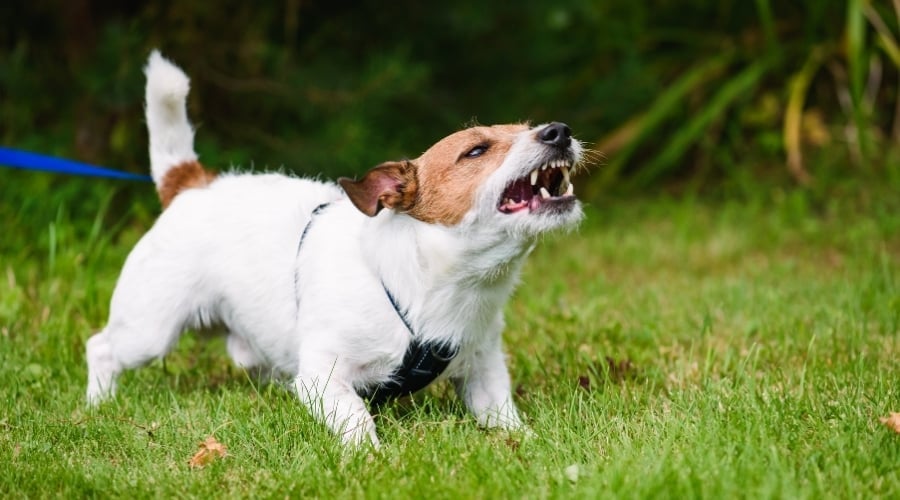
According to a study published in Applied Animal Behaviour Science, dogs often show specific pre-aggression cues, including body language signals that escalate if left unaddressed. Spotting these cues could prevent bites, fights, or frightening confrontations. Here’s what to look for:
- Clenched Mouth or Tight Lips: If your dog’s mouth suddenly closes and their lips press tightly together, it’s not just a resting face: it’s a red flag. This frozen mouth often means your dog is focusing intently on something. If that “something” is another dog or a person, they might be weighing whether to confront it or back away.
- Raised Hackles (Piloerection): The hair along your dog’s back, especially behind the neck and shoulders, may stand up like a mohawk. This isn’t just a sign of fear. It’s often a stress response that can signal defensive or offensive aggression. A stiff, bristled ridge usually means your dog feels threatened and is ready to react.
- Crouched Posture with Weight Shift Backward: When dogs crouch low and shift their weight onto their back legs, they may be preparing to lunge. This isn’t just play. It’s often the body winding up before a burst of aggressive energy. A crouched posture paired with a hard stare or stiff body, it’s time to back off and redirect their attention.
- Hard, Unblinking Stare: If your dog locks eyes with someone or something and refuses to break the stare, they may be signaling a challenge. This is often the calm before the storm. A hard stare is frequently followed by barking, growling, or attempting to chase or bite. It’s a serious warning sign that shouldn’t be ignored.
- Stiff Tail Held High: A high, rigid tail isn’t always a sign of confidence. In tense situations, it can signal that your dog feels the need to assert dominance or protect themselves. If the tail is motionless or flicking quickly from side to side, proceed with caution.
- Growling or Low Rumbling: Growling isn’t just “bad behavior,” it’s communication. It’s your dog saying, “I’m uncomfortable,” “Back off,” or “I feel threatened.” Ignoring a growl can cause the situation to escalate into biting or snapping.
- Ears Pinned Forward or Outward: A dog in a heightened aggressive state may push their ears forward like radar dishes or splay them out sideways. This positioning shows they’re alert and assessing every move around them. Combined with other warning signs, it adds up to a dog that’s on edge and ready to act.
What to Do if You See These Signs
If you notice these behaviors in your dog or someone else’s, don’t wait for things to worsen. Separate them from the trigger if possible, and try to de-escalate the situation without yelling or grabbing. Call their name calmly, use treats or toys to redirect focus, and give them space.
Chronic or sudden aggression should never be ignored. It could be rooted in fear, pain, poor socialization, or even neurological issues. A certified dog trainer or veterinary behaviorist can help assess the root cause and create a behavior plan tailored to your dog’s needs.
Read about more signs of aggressive dogs and how to help their behavior, especially when it comes to aggression toward other dogs.
2. Submissive Behavior: Saying “I Come in Peace”
Submissive dogs aren’t trying to be sneaky. They’re doing their best to keep the peace. Submission is not a sign of weakness. It is how dogs communicate respect, trust, or the desire to avoid conflict. Think of it as doggy diplomacy in action. Dogs rely on clear submission signals to prevent tension, especially during introductions or group settings.

Look for these common cues:
- Looking Away: When your dog avoids direct eye contact, they’re showing they don’t want any trouble. This is a polite way of saying, “Everything’s okay here.” It shows trust toward people and signals peaceful intent to other dogs.
- Exposing the Belly: A dog that rolls over and shows its belly is displaying trust and vulnerability. This is one of the clearest submissive gestures and often shows up during play or when greeting someone they view as more dominant.
- Licking the Nose or Lips: Dogs lick their noses to stay scent-ready. However, frequent nose or lip licking during social interactions often points to nervousness or the need to diffuse tension.
- Licking Others: Licking another dog’s muzzle is a strong sign of respect. When a dog licks a human, it might be showing submission, affection, or simply enjoying your salty skin. Dogs also lick themselves, which is a calming behavior in stressful moments.
3. Timid Behavior: Quiet Signals from a Worried Pup
Timid dogs usually want to avoid the spotlight. Their body language can seem soft or cautious, but that doesn’t mean they’re relaxed. Many fearful dogs stay silent while showing clear physical signs of stress.
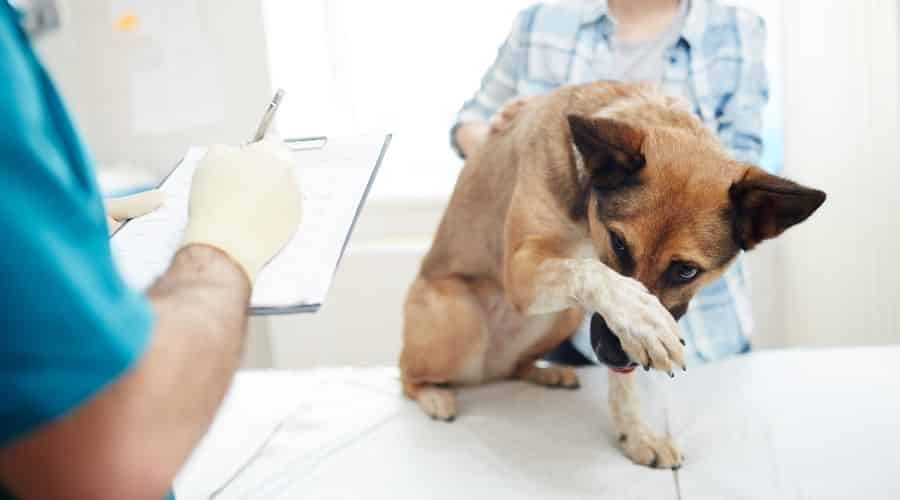
Studies have shown that fear in dogs can stem from early trauma, poor socialization, or even inherited temperament. The American Society for the Prevention of Cruelty to Animals (ASPCA) has found that fear is a major contributor to behavior problems in household pets.
Pay attention to these common timid behaviors:
- Shivering or Trembling: Dogs may shake and shiver for many reasons, including cold, illness, or excitement. But it likely means fear or stress if your dog trembles in specific situations, such as around loud noises or unfamiliar people.
- Yawning (at unusual times): A yawn during bedtime is normal. But when a dog yawns in a tense moment, it’s a way of releasing stress. This calming signal is common in nervous dogs and helps prevent emotional overload.
- Wide Eyes with a Tense Body: If your dog’s eyes are open wide and you can see the whites, that is called “whale eye.” It often means they are uncomfortable or frightened. A tense or frozen body adds to the concern and suggests the dog is trying to stay safe.
- Ears Pinned Back and Tail Tucked: When your dog presses their ears flat and tucks their tail, it shows they are feeling scared or uncertain. This is often paired with a lowered head or hunched body, creating a posture that signals withdrawal.
- Freezing or “Statue” Behavior: A timid dog may suddenly stop moving and hold completely still, often with their head lowered and eyes wide. This frozen posture is a fear response. The dog is trying to avoid drawing attention or escalating a situation. You might see this when a stranger or another dog approaches a timid dog they’re unsure about. It’s their way of saying, “I’m nervous and don’t want conflict.”
4. Excited Behavior: When Joy Turns into a Full-Body Wiggle
An excited dog can light up a room. Their furry energy is contagious, and they often use every part of their body to show how thrilled they are. But high excitement can sometimes look like restlessness or stress, so reading the signs of your dog’s body language correctly is important.
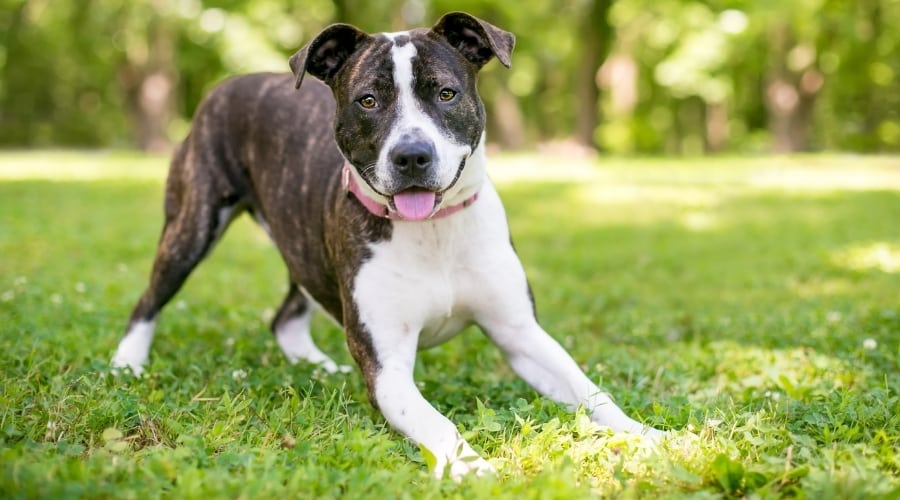
Animal behaviorists emphasize the importance of teaching dogs to manage excitement healthily. Dogs who know how to calm themselves down are more likely to behave well in stimulating situations.
Watch for these signs of a happy, hyped-up pup:
- Panting (when not hot or tired): If your dog is panting in an air-conditioned room right after hearing the word “walk,” they’re likely just pumped up. However, if you’re outdoors and the panting is heavy, you should move them to a cooler spot and offer water right away. Learn more about the signs of heat stroke to prevent your dog from overheating.
- Wide, Bright Eyes and a Wiggle Butt: Unlike fearful wide eyes, excited eyes come with relaxed body movement, a tail that won’t quit, and a big doggy grin. Some dogs seem like they’re vibrating with happiness when they get this excited.
- Happy Barking: A loud bark while watching a squirrel or hearing a knock at the door might mean excitement rather than aggression. Excited barking usually has a higher pitch and faster rhythm. Context matters, so watch the whole body, not just the sound. Barking could be your dog’s way of saying that he’s happy to see another dog on the television or out the window.
- Tail-Chasing or Zoomies: If your dog runs in circles or dashes through the house after a bath, it’s probably just a burst of playful energy. These “zoomies” are common, especially in young dogs. However, frequent tail-chasing without a trigger could suggest boredom, anxiety, or a behavioral issue that needs attention.
- Jumping Up on People: Many excited dogs greet people by leaping up to get closer to their faces. While it might seem like bad manners, it’s usually a sign of overwhelming enthusiasm and affection. Puppies especially do this as a way to say hello and seek attention. With proper training, this bouncy behavior can be redirected into calmer greetings, but the excitement behind it is pure, tail-thumping joy.
Dog Body Language Chart
Here’s a summary of the four types of dog emotions described above.

Facial Expressions: The Eyes, Ears, and Snout of Emotion
A dog’s face is like a mood ring if you know what to look for. Their ears, eyes, and mouths work together to reveal what they’re feeling, sometimes more honestly than words ever could.
- Ears perked up and forward often show curiosity or excitement. Ears pinned back can mean fear, submission, or stress.
- Eyes that are soft and relaxed say your dog is calm. Wide eyes with visible whites (called “whale eye”) are signs of fear or unease.
- Dog mouths that are slightly open with a loose tongue signal contentment. A tightly closed mouth or curled lips could mean tension or discomfort.
Studies from the University of Helsinki show that dogs can even change facial expressions based on human attention, proving they’re not just expressive; they’re watching us closely, too.
That Look Isn’t Guilt: Why We Keep Misreading Our Dogs
People often misread dog body language by interpreting it through a human emotional lens. That “guilty” face your dog gives after knocking over the trash likely isn’t guilt at all. According to a 2025 study published in Anthrozoös, many people mistakenly assign human emotions to canine expressions, which can lead to misunderstandings or even unfair corrections.
The study found that when people interpret a dog’s body language based on human behavior rather than canine-specific cues, they often get it wrong. Learning to read dog signals like tail position, posture, and facial tension can help us respond more accurately and build stronger, more respectful relationships with our pets.
Play Behavior: Zoomies with a Purpose
Dog play behavior is energetic, exaggerated, and full of body language cues that say, “This is just for fun.” A classic play bow with the front legs stretched forward and the rear end in the air is a clear invitation to play. During healthy play, dogs often take turns chasing, pouncing, or gently mouthing each other.
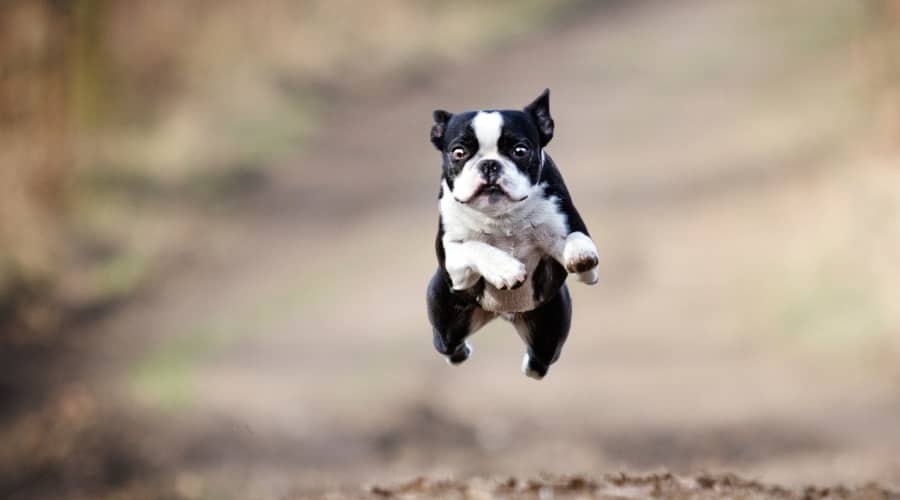
Playful movements tend to be loose and bouncy, not stiff or tense. It can look chaotic, but playtime has rules. If both dogs keep coming back for more and display relaxed body language, it’s all part of the game.
- Play Bow (front legs down, butt up) is a universal signal that says, “I’m just playing, not attacking.”
- Exaggerated movements like prancing or side-stepping show a dog is in play mode.
- Mouthing or light nipping can be part of healthy play as long as both dogs are relaxed and taking turns.
It’s easy to confuse rough play with aggression. The key difference is rhythm and relaxation. Play is loose and silly, while aggression is stiff and intense. Watch for breaks, tail wagging, and mutual engagement to be sure it’s friendly.
Why Does My Dog Run In Circles? The Science Behind Zoomies!
Have you ever settled down for a quiet night, only to have your dog suddenly barrel through the room with a wild burst of energy? Or maybe you’ve noticed their need to frantically run in circles after a bath, leaving you laughing or scratching your head in confusion? This strange and often entertaining behavior is commonly referred to as dog zoomies.
Tail Talk: What Your Dog’s Tail Movements Mean
Your dog’s tail isn’t just there for balance or to knock your coffee off the table. It’s one of their most powerful tools for communication. Like a furry mood meter, the tail reveals what’s happening inside your dog’s head and heart. You can learn a lot, from confidence to caution, joy to jitters, just by watching the wag.
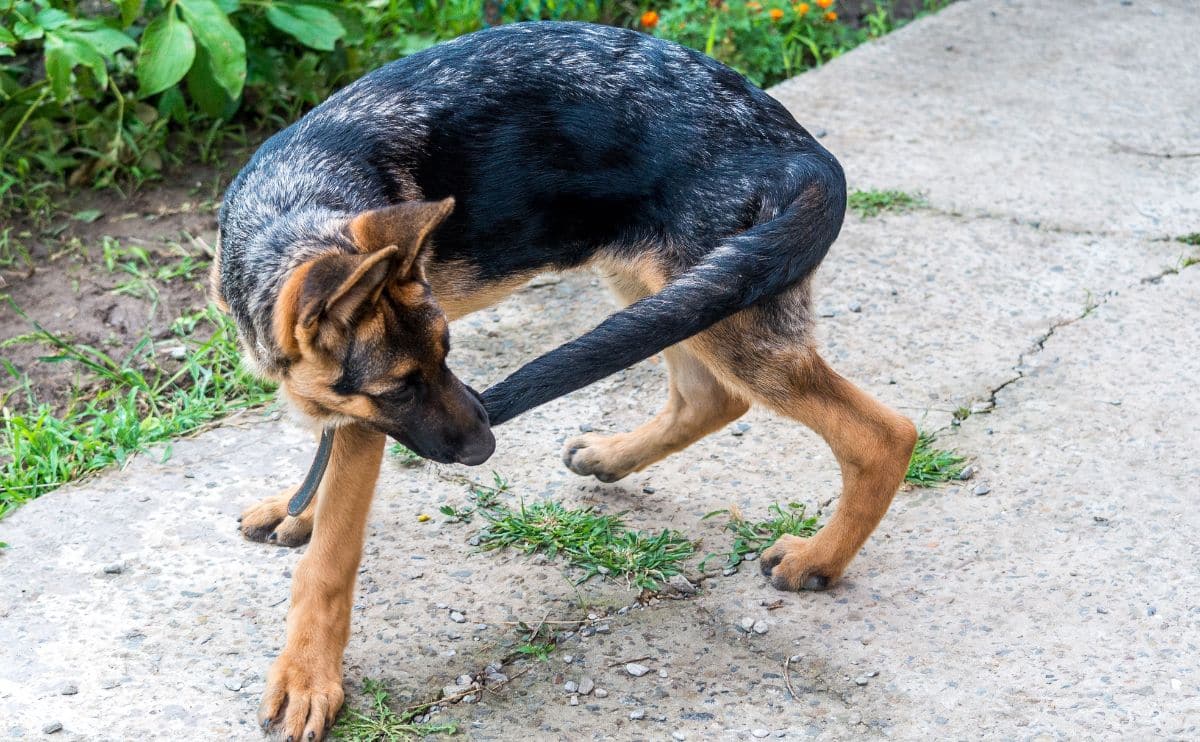
Here’s how to decode the language of the tail:
- Tail Up in the Air: When a dog’s tail is held high like a flagpole, they’re feeling confident, alert, or downright thrilled. A high tail during a walk or while playing is usually a sign your pup is in a great mood. But if the tail is stiff and the body looks tense, they may be laser-focused on something. This could be another dog, a sound, or an imaginary threat only they can hear. It’s not always a red flag, but it’s definitely worth watching.
- Relaxed, Low-Hanging Tail: This is your dog’s version of chill. A relaxed tail, gently swaying or hanging low, says they’re comfortable, calm, and enjoying life’s simple pleasures. Picture a snoozy afternoon in the sun or a slow stroll through the park. This chill tail says, “All is well in my world.”
- Full-Body Tail Wag: When your dog’s tail involves the whole body, you’ve got a seriously happy camper. You’ll see this kind of wag when you walk in the door, say the word “treat,” or grab the leash. The hips sway, the tail whips, and sometimes the back legs do a little happy dance. It’s unfiltered, unapologetic joy, and one of the best feelings in the world to witness.
- Pointed, Tense Tail: A tail that sticks straight out and feels stiff to the touch is a warning signal. It might mean your dog is on edge, uncertain, or preparing to react to something that’s making them uneasy. Sometimes, a tense tail comes with a slow wag, which people often mistake for friendliness. It can mean, “I’m not sure about this, so proceed with caution.”
- Tail Tucked Between the Legs: This is one of the clearest signs of fear, anxiety, or submission. When your dog tucks their tail tightly under their body, they try to make themselves smaller and less noticeable. It’s the canine version of curling into a ball. You’ll often see this posture during scary situations, like thunderstorms, vet visits, or when they know you’ve discovered the chewed-up shoe.
Dog tails are like emotional billboards. They are always visible and always saying something. The next time your pup walks into the room, take a moment to check their tail. It might just tell you everything you need to know.
What Is My Puppy Trying To Tell Me?
Puppies can act more childlike when learning to communicate more effectively as they get older. They also have other growing pains that can cause specific behaviors.
- Chewing – A dog will chew more often than not when he is a puppy. This could be a sign of anxiety, but chewing is just a natural thing certain breeds do to relax and feel comfortable, especially as puppies are teething. Here are some helpful tips to stop your dog from chewing.
- Jumping to greet you – More common in puppies, dogs may jump or put their paws on you when they are excited. While the sign of affection can be cute, you should try to eliminate the action at home so they don’t learn to jump on strangers and do more harm than good.
- Crying – Similar to a baby, puppies are more prone to crying to express their emotions. See some tips about puppies crying and whining in their crate.
Learn more about other common puppy behaviors and find a dog training course for your puppy to help them stop unwanted behaviors.
Beyond Barks: Understanding Canine Sounds and Actions
Let’s be honest: dogs talk. Maybe not in English (yet), but they’ve got a vocal range that can rival a toddler on a sugar high. Growls, barks, yips, sighs, and even complete silence all mean something. Once I started tuning into the how and when my dog made different sounds, it was like the canine subtitles finally turned on. And let me tell you, understanding those sounds has made our relationship so much smoother.

Here’s a breakdown of what those woofs and whines are really saying:
- Growling: Growling gets a bad rap, but it’s not always aggressive. Sure, if your dog is baring teeth and giving off “back away or else” vibes, that growl is definitely a warning. But if there are no teeth and the growl happens during tug-of-war or wrestling with another pup, it might be playful trash talk. It’s like the canine version of friendly smack talk during game night. Learn to read the context, and you’ll know when to laugh and when to step in.
- Barking: Barking is a Swiss Army knife of dog communication. One sharp bark could mean, “Hey! Did you hear that?” A rapid string of barks might mean, “The mail carrier is approaching, and this is my life’s purpose now.” Some dogs bark when they’re bored, others bark when they’re hyped, and some just like the sound of their own voice. I’ve learned to look at body language and the environment to decode it. Is the tail wagging? Probably happy. Is the posture stiff and alert? Might be guarding. Think of barking as the headline. You need the rest of the story to get the full picture.
- Yipping or Whining: These sounds pull at the heartstrings. Puppies whine when they miss you. Older dogs might whine when they’re uncomfortable or anxious. My dog gives a dramatic yip every time I leave the room, like I’ve abandoned him in the wild. If you hear a lot of whining, especially at night or during crate time, it may be time for some comfort, reassurance, or training to ease the stress.
- Groaning, Sighing, or Yawning: Have you ever heard your dog let out a big sigh and collapse on the floor like they’ve had a long day at the office? That’s not sadness, it’s relaxation. Dogs groan or yawn when they’re letting go of tension or settling into a comfy spot. It’s their way of saying, “Finally, some peace and quiet.” Unless paired with other signs of stress, these sounds are a good thing.
- Howling: This one’s in their DNA. Dogs howl to communicate across distances, just like their wolf ancestors. Some pups howl at sirens, others howl when they’re alone, and some just get into the groove with a musical note. Mine howls when I play the harmonica, which is either adorable or a very polite request for me to stop. If your dog is howling frequently, it could signify separation anxiety or a desire to connect with the world beyond the backyard.
So the next time your dog lets out a strange sound, don’t just brush it off. Listen closely. You might be surprised by how much they’re trying to tell you, and how much better things get once you start understanding their unique voice.
The Weird Stuff They Do: Other Quirky Dog Habits Explained
Some dog behaviors are so specific, so strangely human-like, that you can’t help but ask, “What are you doing, buddy?” Whether it’s couch climbing or dramatic head tilts, these actions can seem odd until you understand what’s really going on. The truth is that dogs are never random. There’s always a reason, but they’re too polite to explain it themselves. Here’s what a few of those curious quirks might mean:
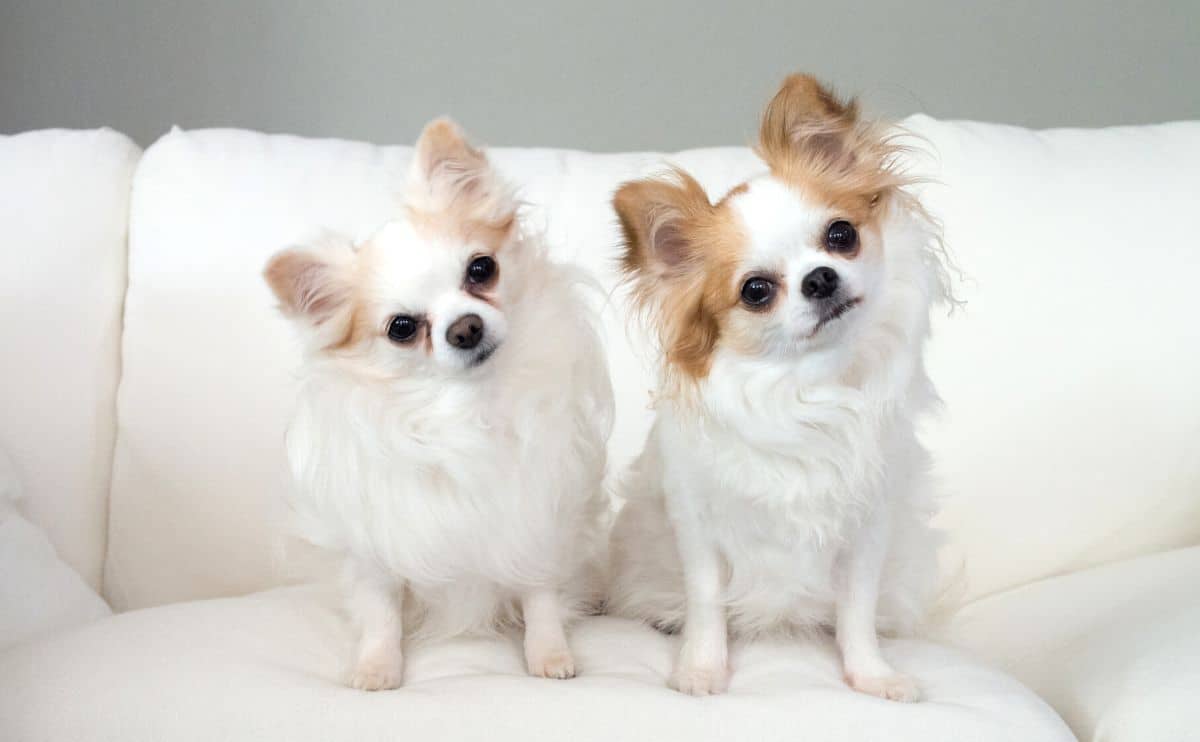
Climbing on the Couch (Especially the Back)
Ever notice your dog scaling the back of the couch like a mountain goat and plopping down above your head? It’s not just about comfort. Getting to a higher spot can be a subtle (or not-so-subtle) power move. In the dog world, height often equals status. Your pup may be trying to claim a dominant or protective position by perching above you. Or maybe they just want to supervise the living room like a furry lifeguard. Either way, it’s a behavior worth noticing, especially if it comes with other signs of pushy behavior.
Scraping the Ground After Peeing or Pooping
Your dog isn’t just being dramatic with those exaggerated post-bathroom back kicks. This isn’t about cleaning up. This is primal territory marking. Dogs have scent glands in their paws, and scraping the ground spreads their unique chemical signature far and wide. It’s basically your dog’s way of posting a “Just peed here. This is mine now.” announcement. Some dogs really go for it, kicking up dirt like they’re digging into Australia. It’s funny, but it’s also serious dog business.
The Head Tilt (aka The Heart-Melter)
That adorable little head tilt? It’s more than just cuteness overload. Dogs may tilt their heads to hear better or locate a sound, especially if it’s unfamiliar or high-pitched, like a squeaky toy or your voice when you say “walk.” It might also signal curiosity, anticipation, or an attempt to read your facial expressions. Some experts even believe head tilting shows empathy or emotional connection. Whatever the reason, it’s impossible not to melt when it happens; your dog probably knows it.
Dogs may not explain themselves, but their actions are often more thoughtful than they seem. Whether they’re claiming couch territory or tilting their head with Oscar-worthy timing, these quirky moves are just another way our dogs communicate, with personality, purpose, and a whole lot of charm. Do you have any experience with dog body language? We’d love to hear about it in the comments below.
Watch and Learn: Dog Body Language Video
Learn more about canine body language by watching live behavior in this helpful video, including photos of what to look for in each expression:
Stress Signals: When Your Dog Is Not Okay
Dogs get overwhelmed, too, and their stress doesn’t always come out as barking or whining. Often, it’s a quiet buildup of subtle signals.
- Lip licking, yawning, or sniffing the ground during a tense moment can signal that your dog is trying to calm themselves.
- Pacing or avoiding eye contact shows discomfort in a situation.
- Sudden shedding or shaking off (like after a bath) can release tension.
If these signs show up frequently, your dog may be struggling with chronic anxiety. According to the American Veterinary Society of Animal Behavior, early intervention with training, enrichment, and sometimes professional support can make a big difference in your dog’s quality of life.
Bond Like a Pro: Understanding Your Dog’s Mind and Heart
No two dogs are the same. While some breeds tend to come with certain quirks, like trying to herd your kids or pretending they’ve never seen water before, it all comes down to the connection you build with your unique pup. Their personality, past experiences, and your day-to-day relationship shape how they behave, trust, and show love.
When meeting a stray or unfamiliar dog, always move with care. Even the friendliest-looking pup can feel unsure or threatened in a new situation. Watch for clear signs of discomfort like a stiff body, a hard stare, a tucked tail, or low growling. Give the dog space, stay calm, and read the signals before reaching out.
The real magic begins when you start to understand how your dog sees the world. Once you learn to interpret their body language, sounds, and little quirks, you stop guessing and start communicating. That’s when things shift. You become more than just the person who fills the food bowl. Your bond becomes stronger, and you become their trusted partner and safe place.
Ready to Strengthen Your Connection?
Start noticing the little things, such as how your dog looks at you, wags their tail, or stretches out with a sigh after a long day. Every move means something. The more you pay attention, the better you will understand them and the closer the two of you will become. Listen with your eyes, connect with your heart, and step into your dog’s world. You already mean everything to them. Now it’s time to show them you genuinely understand. If you need more help, consider an online training course or a professional trainer. They can help you better understand your pup’s behavior and body language.
Why Trust Canine Journal?
Sadie has more than two decades of dog care and ownership experience, specializing in the care and companionship of her beloved Cavalier King Charles Spaniels. Over the years, she’s spent hours of extensive training, collaborating with multiple certified trainers across various settings, from in-home sessions to virtual private lessons to training academies and online courses. She uses positive reinforcement training to build a strong bond with her dogs, emphasizing encouragement and rewards for good behavior. Sadie’s dog suffers from food allergies, and her dogs have had a number of pet illnesses and issues, including anal gland problems, kennel cough, poisoning, cancer, heart murmurs, dental extractions, and more. She works with a dedicated team to provide Canine Journal readers with the most accurate and up-to-date information to help them care for their pups.

